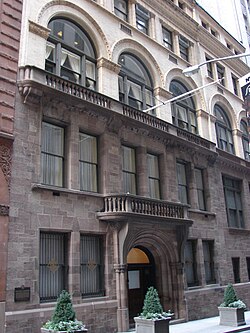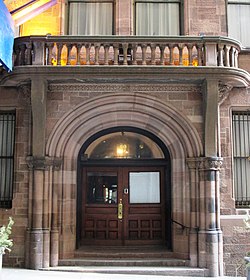Interior
The clubhouse entry on Pine Street gives onto a marble accented lobby with a mosaic tiled floor and fireplace. A cast iron staircase, unique among New York clubs, rises four floors from the rear of the lobby. A large bar and lounging room, paneled in white oak, is reached a few steps down past the staircase. The first floor rear is a large and elegant main bar and gathering area for members.
The principal rooms above the first floor are the Reading Room, the Pine Street Room and larger Wainwright Room, now the Club's ballroom, on the second floor, the A la Carte Dining Room and the Buffet Room and Babcock Room, named for Samuel D. Babcock, the Club's third president, on the third floor and six private dining rooms and the Game Room on the fourth floor. The Game Room, now a members only room, was formerly a private dining room but now contains pocket billiards tables, games tables, a bar and a large collection of hunting trophies. A fitness facility on the fifth floor was built in the former employees locker room.
As originally conceived, and used until the early 1990s, the first floor was for pre-lunch preparation, either at the coat check, the men's or ladies washrooms, the barber or at the bar and oyster bar. The Reading Room was principally used after lunch and was where members could take coffee, port, a cigar, or a nap. All other rooms were for the service of lunch and each had a unique menu. Meals in these rooms were delivered from service pantries and through an extensive system of dumbwaiters from the kitchens which occupied fully half the fifth floor. As the demand for lunch service only transformed into today's full-service, full-day schedule, the kitchen was moved and several of the dining rooms were converted to other uses, principally meetings and banquets and also a gym.

